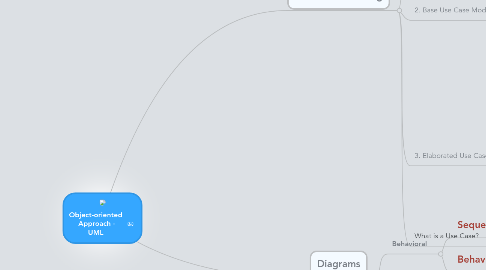
1. Use Case Modeling
1.1. 1. Initial Use Case Modeling
1.1.1. Actor
1.1.1.1. Type
1.1.1.1.1. Primary
1.1.1.1.2. Secondary
1.1.1.2. Goals
1.1.1.3. Deliverable
1.1.1.3.1. Actor Specification Card
1.1.2. Use Case
1.1.2.1. Description
1.1.2.2. Actors Involved
1.1.2.3. Deliverable
1.1.2.3.1. Initial Use Case Description
1.1.2.3.2. Context Diagram
1.1.2.3.3. Use Case Diagram
1.2. 2. Base Use Case Modeling
1.2.1. Sunny-day Scenario
1.2.1.1. Pre-Condition
1.2.1.2. Flow of Events
1.2.1.2.1. Human <--> System
1.2.1.2.2. Human <--> Human (As transition)
1.2.1.3. Post-condition
1.2.1.4. Assumption
1.2.1.5. Priority
1.2.1.6. Alternative Flow
1.2.1.6.1. Suggest alternative flows for Elaborated Use Case Modeling
1.2.1.7. Source
1.2.2. Deliverable
1.2.2.1. Base Use Case Description
1.3. 3. Elaborated Use Case Modeling
1.3.1. Rainy-day Scenario
1.3.1.1. Conditional Flow
1.3.1.2. Extended Use Case
1.3.1.2.1. Additional/Optional Functions
1.3.1.3. Included Use Case
1.3.1.3.1. Repeated/Duplicated in multiple use cases
1.3.2. Deliverables
1.3.2.1. Elaborated Use Case Description
1.3.2.2. Refined Use Case Diagram
1.4. What is a Use Case?
1.4.1. Functions
2. Diagrams
2.1. Behavioral
2.1.1. Sequence Diagram
2.1.1.1. One Scenario (Sunny or Rainy) of One Use Case
2.1.2. Behavioral State Machine Diagram
2.1.2.1. Various States of an object of a Class (from the Class Diagram) over its life
2.2. Static
2.2.1. Class Diagram
2.2.1.1. Base on "Base Use Case Descriptions" of the whole system
